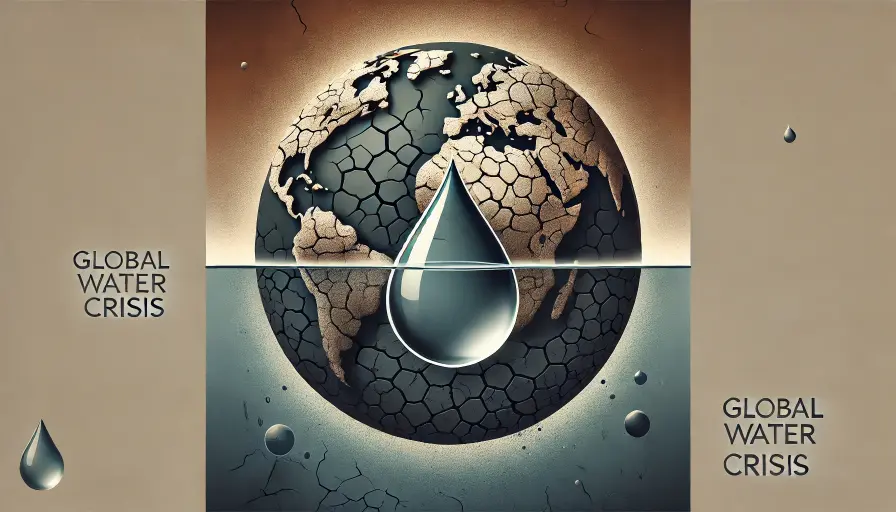Addressing the Global Water Crisis: Challenges and Solutions
Global Water Crises: Water is the essence of life. Every living organism on Earth depends on water for survival, yet today, the world faces a looming and unprecedented global water crisis. With rising populations, urbanization, climate change, and unsustainable water management practices, millions of people around the world are struggling to access clean and safe water. This blog explores the causes of the global water crisis, its impact, and potential solutions to address this growing concern.
Understanding the Global Water Crisis
The global water crisis refers to the increasing scarcity of clean, accessible freshwater in many parts of the world. According to the United Nations, nearly 2.2 billion people lack reliable access to safe drinking water, and over 4 billion experience severe water shortages for at least one month per year.
Several factors contribute to this crisis:
- Population Growth: The world’s population continues to expand, especially in urban areas, putting immense pressure on water resources. More people mean a higher demand for water in agriculture, industry, and domestic uses.
- Climate Change: Climate change has led to more frequent and severe droughts, erratic rainfall patterns, and the depletion of freshwater sources like rivers and lakes. In many regions, desertification is worsening, exacerbating water scarcity and making it harder for communities to access freshwater.
- Pollution: Water pollution is a major factor driving the global water crisis. Industrial waste, agricultural runoff, and untreated sewage contaminate water supplies, rendering them unsafe for human consumption and contributing to the destruction of aquatic ecosystems.
- Overuse and Mismanagement: Overexploitation of water resources—particularly through unsustainable agricultural practices and inefficient irrigation—drains vital water supplies at a faster rate than they can be replenished. Poor infrastructure and wasteful usage patterns further aggravate the issue.
- Inequitable Access: Access to water is not evenly distributed. While some areas enjoy abundant water supplies, others, especially in low-income regions, face severe shortages. Inequitable access to clean water has fueled tensions and conflicts in many parts of the world.
Impact of the Global Water Crisis
The impact of the global water crisis is profound and far-reaching. It affects public health, economic development, food security, and the environment:
- Health Risks: Contaminated water is a breeding ground for diseases such as cholera, dysentery, and typhoid. According to the World Health Organization (WHO), 1.2 million deaths each year are linked to inadequate access to clean water and sanitation. Children are particularly vulnerable, with waterborne diseases being one of the leading causes of death in children under five.
- Economic Consequences: Water scarcity disrupts industries like agriculture, energy, and manufacturing, which depend heavily on water. Farmers are unable to grow enough food, leading to food shortages and rising prices. Water scarcity also reduces productivity and increases the costs associated with obtaining water, creating further economic strain.
- Environmental Degradation: Ecosystems that rely on freshwater, such as wetlands, rivers, and lakes, are being degraded due to overuse, pollution, and climate change. This threatens biodiversity, endangers wildlife, and reduces nature’s ability to maintain healthy water cycles.
- Social and Political Conflicts: The unequal distribution of water resources often leads to social unrest, conflicts, and even migration as people compete for access to water. Water scarcity has been a contributing factor in several geopolitical tensions, particularly in regions like the Middle East and Sub-Saharan Africa.
Solutions to Address the Global Water Crisis
While the challenges are daunting, there are a variety of solutions that can help alleviate the global water crisis. These solutions require collaboration from governments, businesses, communities, and individuals to ensure sustainable and equitable water management practices.
- Sustainable Water Management: Governments and local authorities need to prioritize the sustainable use of water resources. This includes better regulation of water extraction, improving infrastructure to reduce water waste, and encouraging efficient use in agriculture and industries. Countries that implement integrated water resource management have seen better results in protecting their water supplies.
- Improved Irrigation Techniques: Agriculture consumes the largest portion of the world’s freshwater resources. By adopting advanced irrigation techniques, such as drip irrigation and rainwater harvesting, water wastage can be minimized, and crop yields can be optimized.
- Water Conservation Awareness: Public education on water conservation can empower individuals to make changes in their daily lives. Simple practices, like reducing water consumption, fixing leaks, using water-efficient appliances, and reusing greywater, can significantly reduce water demand on a larger scale.
- Innovative Technologies: Innovation is key to addressing the water crisis. Technologies like desalination, water recycling, and atmospheric water generation (extracting water from air) are emerging as viable solutions to produce more freshwater. Additionally, water purification technologies ensure that polluted or contaminated water can be treated and reused safely.
- Protecting Water Sources: Ensuring the protection and restoration of natural ecosystems is vital to preserving freshwater resources. Wetlands, forests, and watersheds play a crucial role in filtering and storing freshwater. Conservation efforts must focus on restoring damaged ecosystems and protecting them from further degradation.
- Global Cooperation and Policy Making: The global water crisis requires cooperation between nations and strong water governance policies. International organizations like the UN and World Bank are playing a vital role in funding water projects, promoting transboundary water agreements, and encouraging best practices for water management.
- Water Pricing Reform: Governments can also use economic instruments like water pricing to incentivize conservation and efficient usage. By pricing water appropriately and subsidizing access for the poor, communities can manage water resources more sustainably while ensuring equitable access.
Frequently Asked Questions (FAQ)
1. What is the global water crisis?
The global water crisis refers to the growing scarcity of clean, safe water due to factors like population growth, climate change, pollution, and poor water management. Millions of people worldwide lack access to clean drinking water, and the problem is expected to worsen if action is not taken.
2. How does water pollution contribute to the global water crisis?
Water pollution is one of the leading causes of the global water crisis. Pollutants from industrial waste, agricultural runoff, and untreated sewage contaminate freshwater supplies, making them unsafe for drinking and other uses. Contaminated water leads to health risks, environmental damage, and a reduction in usable water resources.
3. What are the health impacts of the global water crisis?
Lack of access to clean water can result in waterborne diseases like cholera, dysentery, and typhoid. It also exacerbates malnutrition and can lead to long-term developmental issues, especially in children. The World Health Organization reports that millions die annually due to unsafe water, inadequate sanitation, and poor hygiene.
4. How does Crystal Water address the global water crisis?
Crystal Water provides innovative and sustainable solutions to the water crisis by offering mineral-based water purification systems that eliminate the need for harsh chemicals like chlorine. These products are designed to maintain clean, safe water in both swimming pools and larger water sources, providing an eco-friendly alternative that improves water quality while reducing environmental harm.
5. What makes Crystal Water products different from traditional water purification methods?
Unlike traditional water purification methods that rely heavily on chemicals such as chlorine, Crystal Water’s mineral-based systems use natural minerals to purify water, making it safer for people and the environment. This chemical-free approach reduces water contamination and protects ecosystems from the negative effects of chlorine and other pollutants.
6. How does Crystal Water benefit swimming pools?
For swimming pools, Crystal Water offers a sustainable, chemical-free solution that keeps pool water clean and safe without the side effects of traditional chlorine products. Users no longer have to deal with issues like dry skin, itchy eyes, or the strong chlorine odor. The mineral-based system also extends the lifespan of swimsuits and pool equipment, making it both cost-effective and eco-friendly.
7. Can Crystal Water products be used for large-scale water purification?
Yes, Crystal Water’s technology can be adapted for larger-scale water purification beyond just swimming pools. By offering solutions that reduce dependence on chemicals, Crystal Water contributes to the global effort of providing clean, safe, and sustainable water sources to communities in need.
8. Is Crystal Water’s solution environmentally friendly?
Absolutely. Crystal Water’s products are designed to be eco-friendly and sustainable. The mineral-based system not only purifies water but also reduces the environmental impact caused by chlorine and other harsh chemicals. Furthermore, the water treated by Crystal Water products is biofriendly and can even be used for irrigation, making it an excellent solution for sustainable water management.
9. How can Crystal Water help mitigate the effects of climate change on water supplies?
As climate change leads to more unpredictable and extreme weather patterns, sustainable water management becomes critical. Crystal Water offers solutions that preserve and improve water quality, reduce the need for chemical treatments, and promote better water usage practices. By improving water purification and reducing water waste, Crystal Water can play a key role in helping communities manage their water resources effectively in a changing climate.
10. How can Crystal Water’s products be implemented in communities facing water shortages?
Crystal Water products can be implemented in communities by installing mineral-based water purification systems in local water sources or pools, providing a clean, safe, and sustainable alternative to traditional chemical-based methods. These solutions ensure communities have access to clean water without relying on harmful chemicals, aligning with global efforts to address water scarcity and improve water conservation.
Global Water Crises Conclusion
The global water crisis is one of the most pressing challenges of our time. It affects billions of people around the world and has far-reaching consequences for health, economies, and ecosystems. However, through sustainable water management, innovative technologies, conservation efforts, and global cooperation, we can work together to mitigate the crisis and ensure that future generations have access to the vital resource that is water. It is a collective responsibility to address this crisis and make water security a priority for all.




